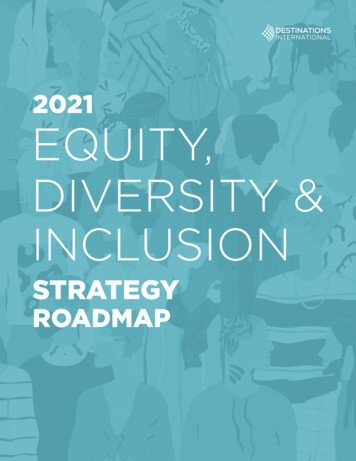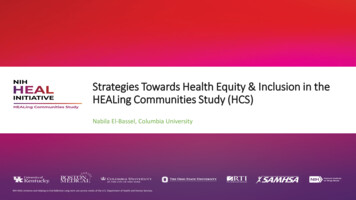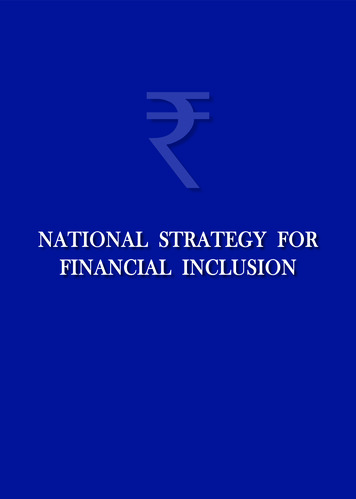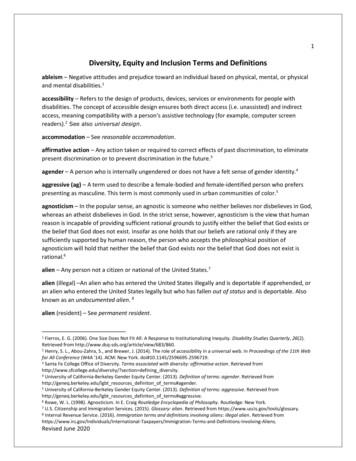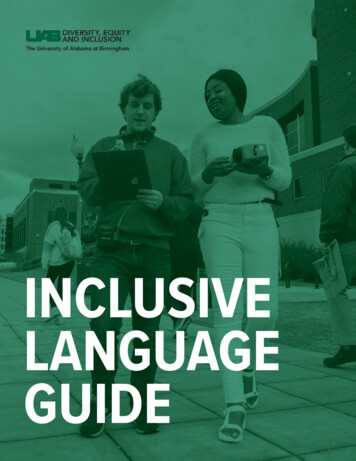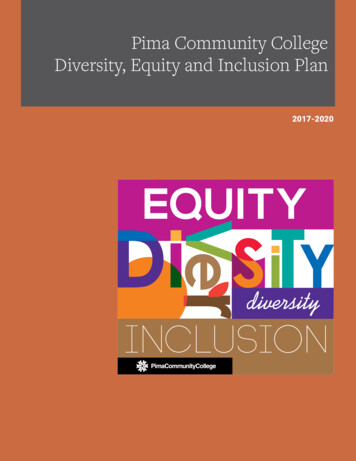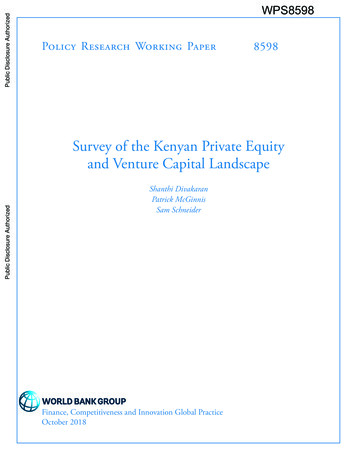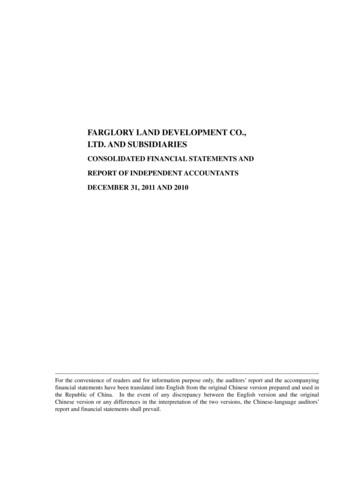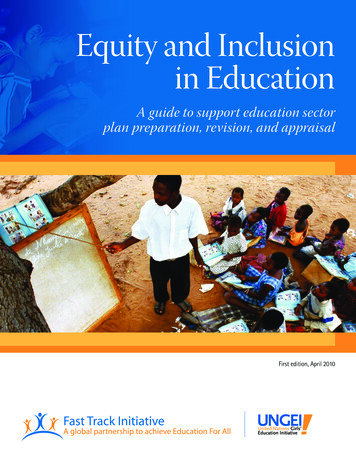
Transcription
Equity and Inclusionin EducationA guide to support education sectorplan preparation, revision, and appraisalFirst edition, April 2010
April 2010This work is a joint product of the UN Girls’ Education Initiative, the UNAIDS Inter-Agency Task Team on Education,the Global Task Force on Child Labour and EFA, the EFA Flagship on the Right to Education for Persons withDisabilities, and the EFA FTI Secretariat. The guide was developed and refined with the expertise of consultants, thelate Hazel Bines and David Clarke.Graphic Design: Critical Stages, LLCEquity and Inclusion in Education
Table of ContentsPurpose3Focus on Equity and Inclusion4Using the Guide4The Equity and Inclusion Guide6A. Baseline data on enrollment and completion . . . . . . . . . . . . . . . . . . 6B. Barriers to equity and inclusion . . . . . . . . . . . . . . . . . . . . . . . . . 7C. Policies . . . . . . . . . . . . . . . . . . . . . . . . . . . . . . . . . . . . . . . 8D. Strategies to promote equity and inclusion . . . . . . . . . . . . . . . . . . 9E. Institutional arrangements . . . . . . . . . . . . . . . . . . . . . . . . . . . 10F. Schools . . . . . . . . . . . . . . . . . . . . . . . . . . . . . . . . . . . . . . 11G. Parental and community participation . . . . . . . . . . . . . . . . . . . . . 12H. Teachers . . . . . . . . . . . . . . . . . . . . . . . . . . . . . . . . . . . . . . 13I. Curriculum . . . . . . . . . . . . . . . . . . . . . . . . . . . . . . . . . . . . . 14J. Budgets and unit costs . . . . . . . . . . . . . . . . . . . . . . . . . . . . . . 15Annex 1: Additional Resources16Annex 2: User Survey17Guidance to support education sector plan preparation, revision, and appraisal1
Acronyms and AbbreviationsECCEEarly Childhood Care and EducationEFA FTIEducation for All Fast Track InitiativeEMISEducation Management Information SystemIATTInter-Agency Task Team on EducationLEGLocal Education GroupMoEMinistry of EducationMDGsMillennium Development GoalsPTAparent teacher associationSMCSchool Management CommitteeUNUnited Nations2Equity and Inclusion in Education
Equity and Inclusion in EducationA guide to support education sectorplan preparation, revision, and appraisalFocus on Equity and InclusionAs progress is made toward the Education for All (EFA) goalsand the Millennium Development Goals (MDGs), includinguniversal primary education and gender parity at all levels ofeducation, increasing attention is being given to the 72 millionchildren who are still out of school.1 In particular, there is astronger focus on the hard-to-reach and those who are at riskof being excluded, marginalized, or otherwise disadvantagedin their pursuit of educational opportunity. Even when suchchildren attend school, they may not complete the full cycle ofprimary education and may not experience or achieve learningof the highest, or even good, quality.At the core of inclusive education is the human right toeducation, pronounced in the Universal Declaration of HumanRights in 1948. Equally important are the provisions of the UNConvention on the Rights of the Child (1989) which stipulatesthe right for all children to receive education withoutdiscrimination on any grounds.2Some children are particularly at risk of not attending orcompleting school – those from poor families; those inremote rural communities; girls; children infected with oraffected by HIV; working children or those with disabilities;children from ethnic or other minority groups and thosein countries affected by conflict or natural disaster. Genderinequality is a cross-cutting issue in every type of educationaldisadvantage. E quity requires securing all children’s rights to education, and their rights within and through education to realize their potential andaspirations.3 It also requires implementing and institutionalizing arrangements that help ensure all children can achieve these aims. Inclusion requires responding to the diversity of needs among all learners, through increasing participation in learning, cultures, andcommunities, and reducing exclusion from and within education. It involves changes in content, approaches, structures, and strategies, drivenby a common vision that covers all children and the conviction that it is the responsibility of the regular system to educate all of them.1Wilson, D. 2003. Human Rights: Promoting Gender Equality In and Through Education.Background paper for EFA Global Monitoring Report 2003/4. Paris.2UNESCO. 2005. Guidelines for Inclusion. Ensuring Access to Education for All. Paris.3UNESCO. 2010. Reaching the Marginalized EFA Global Monitoring Report 2010. Paris.Guidance to support education sector plan preparation, revision, and appraisal3
PurposeThis guide was developed to support the integration of equityand inclusion issues in education sector plans while theyare developed, revised or appraised. It promotes a morecomprehensive and evidence-based approach to providingequitable education, which is at the heart of Education for All.This guide is designed primarily for use by local educationgroups, specifically governments. It can also be used to fosterdialogue and the planning process among other stakeholders,including civil society organizations (CSOs) and communities. The guide complements existing knowledge productsfrom the Education for All Fast Track Initiative (EFA FTI)(annex 1) but focuses on disadvantaged children in societyand their right to education.The development of this guide was spearheaded by the UNGirls’ Education Initiative, the UNAIDS Inter-Agency TaskTeam on Education, the Global Task Force on Child Labor andEFA, the EFA Flagship on the Right to Education for Personswith Disabilities, and the EFA FTI Secretariat.In 2009, the guide was piloted in Kyrgyzstan, Lesotho, andMalawi.4 This first edition is based on the feedback from thesecountries and aims at guiding more FTI partner or FTI-eligiblecountries to prepare, revise, and appraise more equitableeducation sector plans.EFA FTI will solicit feedback (annex 2) from April throughto September 2010 from users in government, developmentagencies, and CSOs. This first edition will be reviewed andrevised in the light of the findings.In Kyrgyzstan, the pilot exercise was conducted by representativesof the Ministry of Education, development partners and nationalstakeholders working in the fields of girls’ education, children withdisabilities and other vulnerable children. The exercise helped raisethe profile of the issues involved and facilitated cooperation betweendifferent agencies in the education sector as well as across sectors.The tool helped shape education policy and strategy and informplanning processes in addressing issues of equity and inclusion.In Lesotho, the pilot exercise was conducted by representativesfrom the various departments of the Ministry of Education andTraining and development partners like the World Food Program,Irish Aid, the World Bank, UNICEF and the Japanese InternationalCooperation Agency (JICA). The exercise clearly revealed that thegovernment had not had a mechanism for undertaking such acrosscutting analysis before. Many participants asked why they didnot have access to the tool earlier. The tool enabled dialogue onissues such as gender-based violence and sexual abuse at schooland the adequacy of the HIV prevention education curriculum.Malawi participated in the pilot exercise during the nationalprocess of preparing its National Education Sector Plan (NESP)for appraisal at the country level. The exercise took place inthe context of a two-day workshop and was provided withconsultancy assistance to pilot the equity and inclusion tool. Thetool was well received by the Ministry of Education. Civil societyorganizations took part in the exercise and gave positive feedbackon the use of the tool. Since Malawi had already finalized its NESP,the tool could not be integrated into the planning cycle early onand benefits were limited.Source: EFA FTI. 2010. Education for All Fast Track Initiative 2009 AnnualReport. Washington, DC.Using the GuideWHOWHAT B ring the right people on board 3 -step approach This guide intends to support the local education group –the government, donor partners, international NGOs andcivil society partners – to identify specific interventions toensure all children their right to quality primary educationwithout discrimination on any grounds. The assessment of equity and inclusion should be based ona participatory process, and include CSOs representingmarginalized and disadvantaged groups; similar tothe development, revision and appraisal process of theeducation sector plan.4Clarke, D. 2009. EFA FTI Equity and Inclusion Tool Report of the Piloting Process.UNGEI. New York.4Equity and Inclusion in Education The guide is intended to facilitate the gathering andanalysis of data on equity and inclusion in the educationsector, particularly at the primary school level.Step 1 highlights key questions to investigate the status ofinequity and exclusion.Step 2 proposes more specific questions for an assessment ofthe focus area regarding equity and inclusion.Step 3 suggests how to prepare and revise the education sectorplan around access, quality and management.
A sk the right questions The working group should help strengthening the interministerial dialogue on issues of equity and inclusion andinvite officials from line ministries such as Ministry ofSocial Affairs, Family or Labor, etc. The guide is organized around ten focus areas: baselinedata on enrollment and completion, barriers to equityand inclusion, policies, strategies to promote equity andinclusion, institutional arrangements, schools, parentaland community participation, teachers, curriculum andbudgets and unit costs. The 3-step approach suggests assessing equity andinclusion with targeted questions addressing educationstatistics; cultural, social, and economic barriers; enablingpolicies and effective strategies; institutional capacity andmanagement; school level practices and support; parentaland community participation; teacher preparation,supervision, and support; the curriculum and monitoringand evaluation. The working group needs to review the guide andconsider adapting it to the local context as necessary.Early in the process the group should discuss a work plan,timeframe, scope, costs, responsibilities, and division oflabor to do this exercise. H old consultation workshops Convene a workshop with all relevant partners tointroduce the guide and the envisioned use in the countryto create a common understanding. This is an opportunityfor government and CSO representatives working withmarginalized groups, to advise on data collection andidentifying strategies for inclusion. S trengthen the understanding of equity and inclusion Reach out to stakeholders at the central and locallevels (government authorities, principals, teachers,social workers, teachers unions, local interest groups,representatives from the communities, and so on)through workshops, consultations, or questionnaires. Thiswill be important to collect information on target groupsand identify their specific educational needs. Broad-basedconsultations will strengthen the process. The outcomes of the assessment will inform policy andstrategy development based on evidence, includingsetting objectives, prioritizing target populations, andselecting appropriate interventions. The local education group can at any time duringthe process of developing, revising, or appraising theeducation sector plan decide to take the suggestedapproach. After the consultation process, the working group will beresponsible for assessing the data and present its findingsin a report to the local education group along withrecommended interventions.HOW S et up a working group Interested partners of the local education group agree towork together in a group according to their interest, areasof engagement, and capacity to assess and respond toissues of equity and inclusion. As part of the FTI appraisal process of a nationaleducation sector plan, countries need to demonstratethat they have given equity and inclusion sufficientconsideration. The report will complement thedocumentation for the FTI appraisal process.5 It shouldalso serve to facilitate policy dialogue among the partnersof the local education group. The group should be chaired by a representativefrom the Ministry of Education (MoE) and shouldinclude representatives from key MoE departments,donor partners ideally with representation from thecoordinating agency, and international NGOs as well asnational CSOs. The MoE – possibly with support from the coordinatingagency or a donor or CSO partner – will take the lead inorganizing, planning, and reporting on the exercise.5Appraisal Steps 1 and 2; Tables 1, 2A and 2B: EFA FTI Secretariat. March 2006.Guidelines for Appraisal of the Primary Education Component of an Education SectorPlan. Washington, DC.Guidance to support education sector plan preparation, revision, and appraisal5
The Equity and Inclusion GuideA. Baseline data on enrollment and completion1Access by disadvantaged groups1. Which groups of children are still not enrolled in primary school?Key questions for investigatingthe status of inequity and exclusion2. Which groups of children do not complete primary school? Are gender-disaggregated data available on educational disadvantage ata sub-national level? What are the main gaps in data about children who do not completeprimary education?2Distill baseline data on enrollment and completionGuidanceTo find answers to key questions, you may needto ask additional probing questions such as: How many children are currently out of primary school(disaggregated by gender)? Are data on attendance available? What are the mainpatterns of attendance? Which groups of children are excluded from enrolling,attending, and completing primary education? Considerfactors such as gender, ethnicity, disability, migration, HIV,urban or rural locations, child labor or poverty. What are the enrollment and completion rates for childrenwith disabilities and special educational needs? How manyare served by general schools and how many by specialschools? Are disaggregated data available on learning outcomes? In which regions of the country are enrollment andcompletion rates comparatively low?3Preparing or revisingthe education sector plan Use available data on enrollment, retention, and completion. Key sources ofdata include Education Management Information System (EMIS), MultipleIndicator Cluster Survey (MICS), and household surveys. Other potentialsources of information are survey data on: Children living with and affected by HIV Street children Child labor Minorities Children with disabilities Migrant families Girls’ education Analysis of data should identify: Children currently excluded from school Attrition and dropout rates Children most at risk of not enrolling, attending or completing Student flow rates Key trends and patterns Information gaps Data should be presented and analyzed for both national and decentralizedlevels of the sector. Data should be disaggregated by age, gender, rural/urban, and by region/district, etc.Questions to considerAccess Are costed strategies required to address the situation of any groups ofexcluded children (e.g., girls, children with disability, ethnic minorities,children affected by HIV, etc.)? Are there any excluded groups that would benefit or already benefit fromtargeted interventions that need to be scaled up? Are there any knowledge gaps in relation to equitable access? What changes are required in the current approach in order to increaseequity and inclusion?Quality How equitable is the quality of education?Management Does the EMIS need to be adjusted to collect more data on different groupsof children? Is there a need to develop additional technical capacity to address the needsof excluded or disadvantaged groups (e.g., children with disabilities)?6Equity and Inclusion in Education
B. Barriers to equity and inclusion1Key questions forinvestigating thestatus of inequityand exclusion21. What are the major factors affecting enrollment, attendance, and completion by children?2. How does gender influence these factors? Has a gender analysis of the sector been undertaken?Assess the following types of barriersGuidanceTo find answers to key questions,you may need to ask additionalprobing questions such as: Have barriers in relation to boththe demand for and the supplyof education been analyzed? If sowhat were the results? How are school attendance anddrop-out rates monitored? Whatare the main causes of droppingout? What are the main barriersto school completion? What are the underlying causesof unequal participation?3Identify barriers to access and qualityPreparingor revisingthe educationsector planSocial factorsSectoral factorsInfrastructural factors P overty, and financial barriers,including direct, indirect, andopportunity costs of schooling G ender Biases e.g., toward girls,children living with oraffected by HIV, children withdisabilities, ethnic minorities L ack of identificationdocuments/birth certificate M igration and mobility P revalence of child labor onplantations, in industry, or theinformal economy H ealth and nutritional statusof children C onflict Lack of school instructionmaterials Legal and policy barriers Lack of appropriateinfrastructure for childrenwith disabilities Quality of teaching and teachertraining The number of teachersper class Attrition rates of teachers andnonteaching education staff School safety, violence, sexualharassment, and corporalpunishment Lack of transportation, distanceto school, lack of water andsanitation at school Poor condition of schoolfacilities Seasonal factors such as rains/flooding Remoteness and lack of ruraldevelopmentConsider strategies to address the barriersAccess What are the key barriers toequity that need to be addressed? Are current policies andstrategies working to increaseequity and inclusion? Whichinterventions show evidence ofeffectiveness? What changes are required in thecurrent approach to increasingequity and inclusion?Demand-side strategiesmay include: Abolition of school fees andreducing hidden costs such asuniforms and books Community mobilization Support for bridging programsfor returning child workersto school Addressing stigmatizingattitudes in the school towardsmarginalized children School meals/nutrition School health servicese.g., de-worming C ash transfers for vulnerablehouseholds E arly childhood care S econd chance/re-entryprogramsQuality W hat are the key factors thatundermine the equitable deliveryof quality education? W hat are their root causes?Are policy changes required? I s MoE institutional capacityadequate to address issues ofequity and inclusion? W hat changes are required in thecurrent approach to increasingequity and inclusion?Supply-side strategiesmay include: Pre- and in-service teachertraining in knowledge and skillsrelating to inclusive schools/inclusive education Improving school facilities Developing child-friendlyschools and classrooms P roviding clean drinkingwater and sanitation forboys and girls E nsuring that the curriculumpromotes inclusion T argeted interventions formarginal populations anddistricts T eacher policy developmentto address workplace issuesManagement A re objectives and targets beingset to improve equity? Are thesefully appropriate? W hat changes are required in thecurrent approach to increasingequity and inclusion? W hat capacity building orstrengthening measuresare needed in educationalmanagement? C onsider including thesemeasures in a capacitybuilding plan.Guidance to support education sector plan preparation, revision, and appraisal7
C. Policies1Enabling environmentKey questions for investigatingthe status of inequity and exclusion21. What policies are currently in place in relation to equity and inclusion ineducation?2. How are policies disseminated and implemented?Undertake a policy analysisGuidance Are there clearly defined education sector policies or legislation on: The right to educationTo find answers to key questions, you may need toask additional probing questions such as: Inclusive education What are the main commitments of existing policieson equity and inclusion in the education sector? Children living with oraffected by HIV, and HIV in theworkplace Are there mandatory and enabling policies thatsupport inclusion and allow for decentralizeddecision making? Gender and education Children with disabilities Education and child labor Minorities and the languageof instruction Early childhood care andeducation (ECCE) and vulnerableand disadvantaged children Children from extremely poorhouseholds School health and nutrition School safety, sexualharassment, and violence HIV workplace policy Teacher/staff codes of conduct When were these policies approved/revised? Map any gaps in policy provision. How do policies reflect international commitments e.g., UN conventionson child rights, gender, disability, and child labor? How are these policiesreflected in national education sector strategies? What mechanisms are inplace to ensure that policies are fully implemented as intended? Are thepolicies equitable? Describe how policies are disseminated (and to whom). Are policies availableand communicated at school and community level? How is policy implementation reviewed? How often? Are the policies working? If not, what needs to be done?3Preparing or revisingthe education sector planIdentify where new policies are required orexisting policies need to be better disseminated What were the main findings of the stock-taking exercise on policies? Are there any significant gaps in policy formulation, dissemination, orimplementation? Do the following need to be considered? An overall policy on equity and inclusion; Addressing gaps in existing policies.Access Policy development on the education of girls/boys, children with disabilities,ethnic minorities, children affected by HIV, children disadvantaged bypoverty, remoteness, etc.Quality Policy dissemination; Training and awareness raising on policies.Management Monitoring policy implementation.8Equity and Inclusion in Education
D. Strategies to promote equity and inclusion1Effectiveness of current interventionsKey questions for investigatingthe status of inequity and exclusion1. What strategies are currently in place to increase equitable access toeducation for children who are at risk of a) not enrolling and b) notcompleting primary education?2. Which of these strategies are working and need to be continued?3. Which strategies are not yet working but need to be adjusted or strengthened?4. Which of these strategies are not working and need to be dropped?2Complete a strategy analysisGuidanceTo find answers to key questions, you may need to askadditional probing questions such as: How effective are current strategies in increasing equity andinclusion? Which strategies are working? Which strategiesare not working well and need to be revised? Whatquantitative and qualitative evidence is available to assessthe effectiveness of strategies? What are the coverage rates of targeted interventions? Have any objectives or targets been set to increaseeducational equity and inclusion? Are these appropriate? To what extent are the current strategies supported byclearly defined policy?Map and assess the current range of strategies/interventions aimed atincreasing equity and inclusion. How effective is the response to the problemsidentified in the situation assessment?Current strategies may include:Access Early childhood care Universal measures such as abolishing Creation of an inclusive curriculumschool fees and reducing class size L ocal content included in thecurriculum Flexibility in the school calendar School construction and refurbishmentQuality Reviews of the curriculum,textbooks, and teachers’ guides toconsider how gender, disability, HIV,Preparing or revisingthe education sector plan School health and feeding/nutritionprograms T argeted interventions such asscholarships for girls, social protection Increasing female participation inteaching and school managementtools such as income supplements forchild-headed households, etc. Teacher education on equity issuesand inclusive education Incentives for teachers to work inrural/ remote areas3and other issues relevant to equityand inclusion are addressedManagement Teacher deployment incentivesfor rural areas Community mobilization/participation in school managementConsider new strategiesStrategies to consider may include:Access C reation of an inclusive curriculum Abolishing school fees andreducing class size S chool health and feeding/nutritionprograms School construction and refurbishment T eacher education on equity issues,gender, and inclusive education Targeted interventions such asscholarships for girls, social protectiontools such as income supplements forchild-headed households, etc. Expansion of ECCE for particularlyvulnerable children Second-chance opportunitiesQuality Reviews of the curriculum, textbooks,and teachers’ guides to consider howgender, disability, HIV, and other issuesrelevant to equity and inclusion areaddressed and to eliminate biasManagement Teacher incentives in rural areas Increasing female participation inteaching and school management Targeted resources/teacherdeployment incentives fordisadvantaged/remote schools Community awareness raisingon gender issues Community mobilization/participation in schoolmanagementGuidance to support education sector plan preparation, revision, and appraisal9
E. Institutional Arrangements1Capacity issuesKey questions for investigatingthe status of inequity and exclusion1. What are the institutional arrangements to promote equity and inclusionin education?2. How are issues such as gender and HIV mainstreamed in the Ministry ofEducation?3. How is educational equity monitored?2Undertake a capacity assessmentGuidanceTo find answers to key questions, you may need to askadditional probing questions such as: Has any capacity assessment of the Ministry of Educationbeen undertaken in regard to equity and inclusion? What arrangements are in place to coordinate andcollaborate with other government ministries such asHealth, Gender, Family and Social Welfare, Labor, and so on?Are these arrangements effective? This should assess the effectiveness of current institutional arrangements toaddress equity and inclusion issues at: a) central, and b) decentralized levelsof the sector. Map which departments are responsible for ensuring educational equity andinclusion. How is this reflected in their terms of reference/mandates? How isprogress in education equity and inclusion reported to Ministers? Identify any critical gaps in capacity to address equity and inclusion,including in institutional arrangements and technical areas (gender, disability,ethnicity, HIV, school health, etc.). Who is responsible for managing equity and inclusion strategies at centraland decentralized levels? What school health or counselling services or both areavailable to the education system? Assess current institutional arrangements for monitoring equity andinclusion. Where do these exist, are they effective? What training is available to planners and educationmanagers on equity and inclusion issues? Assess how effectively children/young people, parents, and communities(particularly representatives of excluded groups) are involved inmonitoring and evaluation. Consider private as well as public education providers. Consider how equity and inclusion issues are included in educationstatistics. What indicators are used? How adequate are they? How isequity included in monitoring and evaluation for the sector? Are there any interdepartmental committees, specialized units, focalpoints, or coordinating mechanisms to enable work across departmentson crosscutting issues such as gender, HIV, school health, etc. What aretheir functions? Are they effective?3Preparing or revisingthe education sector planStrengthen institutional arrangements What institutional strengths and weaknesses were identified in thestock-taking exercise? What institutional strengthening is required at: a) central, andb) decentralized levels of the sector? What strengthening is required in educational planning and management?How will this be delivered? What additional measures will have to be taken to strengthen monitoring ofequity and inclusion at all levels (national, decentralized, school)? Have key indicators to monitor equity and inclusion over the plan periodbeen selected? Examples of targets or indicators are: Equal access to and enrollment in school of all children regardless of background Equality in the learning process by all children, regardless of background Equality in achievement levels regardless of background Increase in school enrollment by target groups Increase in number of targeted children receiving ECCE Percentage of teachers trained in equity and inclusion10Equity and Inclusion in Education
F. Schools1School management1. How are schools managed to ensure that they are child friendly or girl-friendly?Key questions for investigatingthe status of inequity and exclusion22. How welcoming and safe are schools for girls, children with disabilities,disadvantaged children, or in
to September 2010 from users in government, development agencies, and CSOs. This first edition will be reviewed and revised in the light of the findings. Step 1 highlights key questions to investigate the status of inequity and exclusion. Step 2 proposes more specific questions for an assessment of the focus area regarding equity and inclusion.

